Entries tagged with “fiber festival”.
Did you find what you wanted?
Sun 15 Apr 2012
The final countdown is on…we leave for the show on Thursday. I have quite a pile of fiber (about 150 braids) waiting patiently in boxes, a basket full of sample skeins and sweaters spun from hand dyed and spun yarn, and today I have one more sweater to add to the pile:
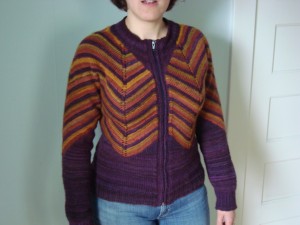
The striped shawl sweater (which really needs a better name) is done. I finally finished the zipper this afternoon, and now it just needs its second and final blocking.
I am mostly happy with how it came out. I like the design itself even more than I thought I would, but it came out a little bit too tight around the waist and hips because of a couple of extra decreases that would have been better left out. I tried it on after blocking for the steek and it seemed to fit just fine, but wearing it around the house today I can tell it’s still a little tight. Between that and the way this construction stretches, it tends to ride up just a touch. You can see that a little bit in the back.
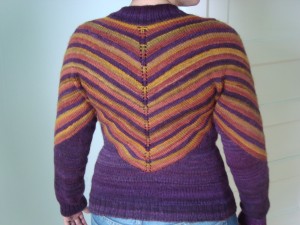
There’s a tiny bit of a crease at the point of the triangle, and a bit of bunching under the arms. Both of those go away with a little bit of tugging, though, so I’m hoping that it will relax out with the second blocking. An extra inch would take care of both. Or, I could always just wear it open.
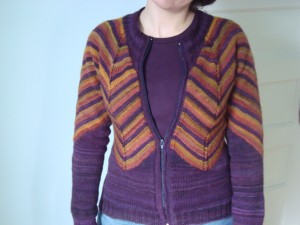
I very much like having the power of steeking in my toolbox. This is my second steeked sweater in a row now, and the first where I picked up stitches and knit a button band (the purple stripe around the zipper is picked up and knit). I’d show you close ups, but my camera ran out of battery and refused to take any more pictures, so that will have to wait for another day.
I wanted to try a crochet steek on this sweater, but found out that that method shouldn’t be used close to the end of a row. Since all of my color changes happened in that front band, I decided to stick with a machine-reinforced steek instead. I ended up using two rows of machine stitching, and then just folding it over and tacking it down. There’s a piece of grosgrain ribbon attached to the zipper inside to help protect the raw edge, and it looks very secure to me. I’m already working away on the next sweater design, and I suspect that it may also have a steek. I have quite a few pullover sweaters now, and am really looking forward to having these new cardigans in my wardrobe. (Bright lights has been getting a ton of use, now that the weather is starting to warm up a bit.)
I’m happy to have the striped shawl sweater finished in time, because I think it will make a fun sample for the show booth. It’s a good example of what you can do to mix different handpainted colors into a wearable garment. The sweater is one of the lightest I’ve made, weighing in at 1 lb, 1 oz. It took 5 braids of fiber because I needed just a little more purple to finish the body.
Linda and Walden have been knitting away at their test knits for the shawl version of this design. You should go take a peek; it’s really interesting to see how the different yarns and colors highlight the geometry of the increases. I can’t wait to see how the final versions come out!
I also finished spinning up a sample of the new Rambouillet for the booth.
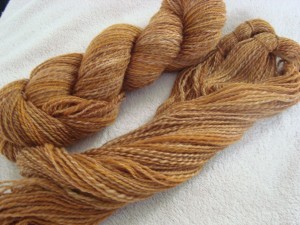
I ended up with about 470 yards of 2-ply fingering weight. Somehow I am still having trouble breaking through that fingering-to-laceweight barrier. I’m not sure whether to blame it on the wheel or on myself, but my best attempts at a fine yarn have all been coming out in this range, even using the smallest whorl on the lace flyer. It’s just difficult to get enough twist into the yarn to keep it fine. Some sections of these skeins are in the heavy laceweight range, though, so I think there may be some hope of figuring out how to go finer yet.
This color isn’t one that I would usually gravitate toward on its own, but I am itching to use it. The words “leaves of grass” are all I can think when I look at those skeins, and I’m thinking it will turn into something lacy with a wheat-ear theme. Time will tell, though. The Rambouillet spins like a dream and puffs up into a beautifully fluffy yarn, and I have a feeling that it will bloom even more after it’s bath. It’s upstairs drying right now, so we’ll know soon!
Mon 9 Apr 2012
As we get closer and closer to the fiber festival, it’s time to stop and take stock of the dyeing. I finally banded up all the braids last night, and then laid them all out to see the colors. The bottom row is polwarth, then falkland, then BFL, rambouillet, and shetland.
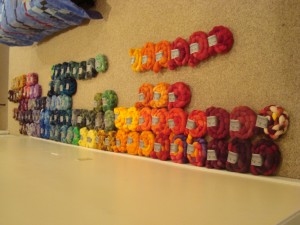
These are mostly semisolid colors, with just a few gradients and multi-color braids thrown in here and there. Next, I’ll be turning my attention back to the real painted fibers with multiple colors, but first I wanted to get a sense of where things stood.
In general, the color distribution looks pretty good. Lots of blue-greens and purples (no surprise there), a few browns, a surprising number of orange. Not much in the true/dark reds, the true blues, or the bright greens and yellows, so those are places to maybe make some more. Also, a few real pinks couldn’t hurt.
We also finished another project for the show this weekend. We’ve been looking and looking for ways of displaying items, and haven’t found much that was a) attractive b) portable and c) relatively inexpensive. So, we made something.
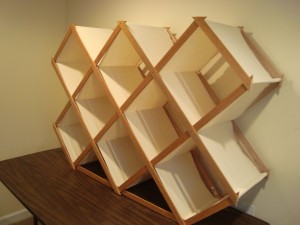
I bought some canvas at Joann’s using one of their 50% off coupons. On Friday, I pulled out my trusty sewing machine and set to work. First, I cut the fabric into strips and sewed the strips together to make pockets. Then, Branden cut and assembled the frame over the weekend. We’re both really pleased with how this came out. I am thinking that it may become a permanent addition to my fiber room after the show. (I’m also thinking I might need a few more…)
Of course, I like it even better when it’s full of fiber.
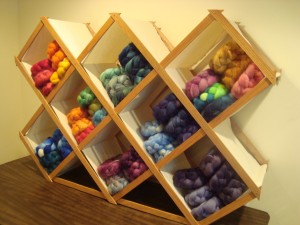
And the best part?
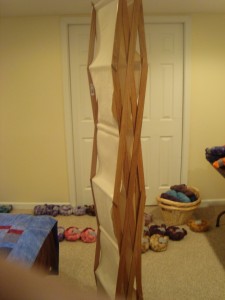
It folds up when it’s not in use, so it’s really easy to slip into the car when it’s time to go. We’re getting close!
Fri 6 Apr 2012
…makes Jack a dull boy, right?
Since most everyone seemed to be leaning toward play (and since I had some pretty strong leanings in that direction myself), I decided to try spinning the second half of the gradient as a short repeat yarn.
As instructed, I kept it simple. No overthinking…not even a bit. (Who me? Overthink? Never!)
I split the top along its full length, making 10 very narrow strips.
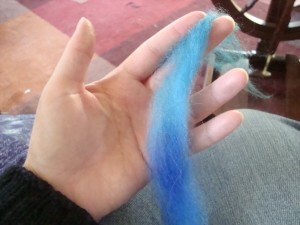
Then I spun them, one after the other until I ran out. (I was also careful to keep the cats out of the pile while I was spinning. This was critical, and proved to require more attention than I expected. Apparently lots of little strips of fiber = warm nest in the mind of a cat.)
I chain plied the singles like I did for the first skein, and ended up with about 2 yard lengths of each color (compared to about 20 yards per color in the previous skein). You can see the difference in the color distribution here:
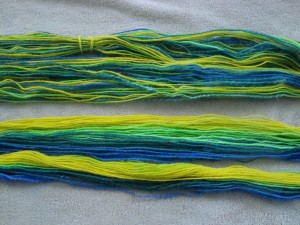
And the two skeins together:
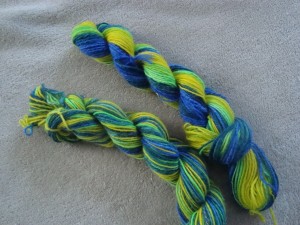
True to form, I like the long repeat version better in the skein, but I’m really not sure which I would prefer in the knitting.
I’d started out spinning this yarn expecting it to become a pair of socks, so I spun a (slightly heavy) sock weight. But then I was thinking about it, and I wasn’t sure that I wanted that long a gradient along the length of just one sock. That’s where the possibility generator kicked in and suggested that shorter repeats would be nice, so that there would just be a few rounds of each color in repeating stripes.
For a sock, I think I’d much prefer the shorter repeat version. I’d guess that there would be 3, maybe 4 rows per color, and then the colors will repeat every half inch or so, for the full length of the sock.
If I were to knit this into a shawl or a larger garment, then the long repeat version would look really good striped with a darker solid color. Of course, you could also alternate sections of long and short repeats to get all kinds of interesting combinations, too.
Because this is me, I no longer want to use this yarn for socks. My brain somehow manages to take a sharp left turn every time I sit down to think about knitting socks. Sweaters and shawls and bigger things are just much more exciting for some reason. (Also, I like my socks to match, which might be hard with this yarn now.)
Last night, I was having visions of a stranded colorwork bag, with the bright yarn worked on a dark blue background. But today, a mischievous little voice is suggesting that they would look very nice woven.
I said I didn’t overthink the spinning. I didn’t promise anything at all about the using of the yarn.
(Of course, all these ideas just mean more decisions, but that woven idea is pretty sticky. I think it might win.)
Wed 21 Mar 2012
One of the reasons for doing a fiber festival this year was to see how the business side of DesigKnit would scale. It’s an experiment, really; designed to help us identify and work through the sticky spots that are sure to crop up as things get bigger. (It’s always easier to work your way through the hurdles in a controlled experiment than it is when you’re doing things under pressure or on the fly.)
Fortunately, the first part is easy. I have no trouble at all thinking up more colorways. In fact, even with increased production I am still not even scratching the surface of things I want to explore. Everything I do suggests 5 more things to try. No problems there.
We’ve had a few jumps and starts with sourcing larger amounts of fiber. My staple products were no problem, since I just worked with my usual vendor and made a bigger order. We worked out a deal that made both of us very happy, and that was that.
The trouble came in when working with new vendors. I mentioned earlier that I wanted to start stocking Targhee and Rambouillet. It turns out that the Targhee is back ordered for some unknown period of time (waiting for wool to come back from the mill is a very unpredictable thing), so that’s on hold for now, pending further notice. The Rambouillet was in stock, and I was excited about buying directly from a small farmer, but she abruptly stopped returning my emails as soon as I asked about wholesale prices. I don’t know why, and it’s doubly unfortunate since I would have considered paying retail prices for the fiber, but there you have it. Sometimes things don’t go as planned.
This led me off on a quest to find more Rambouillet, at a reasonable price. I didn’t find another farmer, but I found someone that sells large quantities of commercial top. We had to really bite the bullet to pay for three times as much fiber as I’d have liked to order (30 lbs is a lot of fiber!), but we will be all set with Rambouillet for the forseeable future. This is a much more commercial prep, with a little less of the “sheep” left in the fiber. The other was clean and well processed, but it felt a lot closer to wool the way it comes off of the sheep than the more heavily processed version. If you’ve ever bought top at a sheep festival compared to a commercial prep, you know what I mean. (If you haven’t, get thee to a sheep festival to see the difference!) The new fiber is not as spongy as the mill-processed top, but because of that it drafts much, much more smoothly. Honestly, I like spinning it better than the other, though I always have a guilty preference for highly processed top, because it is so smooth to spin. It’s a beautiful fiber, and I’m excited to have it.
So we have the fiber and the dyeing worked out, but we just can’t seem to work our way around the pictures. Getting color accuracy in photos is notoriously difficult, and it seems that I tend to dye colors that are particularly hard to capture. Branden has been patiently clicking away, taking sometimes hundreds of photos with different settings before he gets one that works, but we still haven’t narrowed down the important variables. We think we have it with one batch, but then the same changes just don’t work on the next, and we end up starting all over again.
This has been a problem for a long time, but it wasn’t too bad when I was only producing a handful of colors at a time. It takes longer to take good photos than it does to dye the fiber, but we both like a challenge and we felt it was worthwhile. Now, though, I am making up to 20 colors in a single dye day, and the photography just can’t keep up. We have tried everything we can think of; changing the lighting, using different white cards and white balance settings, tweaking and adjusting every setting on our manual DSLR cameras. We started taking the photos in RAW format and trying to tweak them manually, but we’re not yet very good with the software and it takes forever to get right. (I am also terribly impatient with that part of the process: just thinking about it makes me break out in hives.)
Needless to say, we’ve ended up with quite a backlog of colors waiting to be photographed. After spending a good 6 or so hours of limited weekend time every weekend for weeks on end, we’re both pretty frustrated. Clearly, this is something that still needs work.
So, in an effort to keep things moving along, we’re going to try to take pictures of just a small subset of fibers for posting on Etsy and the blog. I had wanted to give the blog first go at the new colors that I’m making, but there is just no practical way to make that happen until we figure out this camera thing. Unfortunately, no pictures also means that I have no record of the colors that I’m making, and it changes the bookkeeping side of things, but for now I think that’s just how it has to be.
We will try to post photos of as many things as we can, but I’m not sure yet exactly how that’s going to work out. It would be easier if I wanted to just settle into a few standard colorways, but that takes the fun and the experimentation out of dyeing for me, so we’re going to have to find a way to make it work with more varieties.
Not posting all of the fibers has been a hard decision for me to make, because I hate secret projects. One of the promises that I made myself at the beginning of this little business venture was that I wouldn’t do anything that I couldn’t blog about. (That’s particularly important with patterns, since it dictates a lot about places you can and can’t publish.) Blogging is the first thing I want to do when I make a new set of colors or think up a design, and it blocks my process when I can’t talk about the things that I’m working on and excited about. It also makes for really boring blogging, and long silences.
So, we’re still working on that part. The good news is that I do still like to dye, and I don’t think I’ll ever run out of colors to try. I’ve been dragging my feet over the past few weeks, not wanting to dye anything new until we had photos of the old colors, but I really need to ramp it up in the next few weeks to get ready for the show. In the meantime, we’re trying to figure out how to smooth over or get around the other bumps in the road, trying to find a way to scale this process in a positive way.
For now, I need to go plan out the next dye session; there are so many more colors to make!
Fri 24 Feb 2012
I am yet again building up a list of small things going on behind the scenes that never quite make it to the blog. I think it is time for a catch up post.
Item the first:
I joined a new spinning group last month, and they have monthly workshops. I wasn’t terribly excited about the January meeting, because I’ve never been at all interested in needle felting. But I’ve found that one of the best things about being part of a group is trying things you wouldn’t otherwise do, so I went anyway. And I have to say I was pleasantly surprised. The poke-poke-poking went a lot faster than I had thought it would, and in the right frame of mind it’s even kind of relaxing. And, I really like the results:
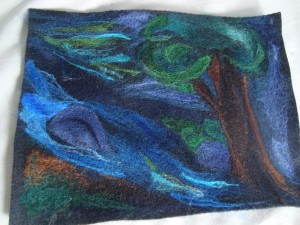
I doubt that I’m going to convert instantly to a needle-felting junkie, but it was just the right thing for my recover-from-interview  days last week. So, I started a flower.
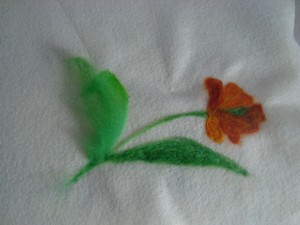
The nice thing about needle felting is that it finally gives me something to do with all the bits and pieces that I pull of of my fiber when I’m braiding it for the shop. There are always a few little pulls here and there, and the ends usually get a little felted, so I end up with a small handful of fiber from almost every colorway I make. I’ve been putting them aside as too good to throw out, and now I have quite a fun palette.
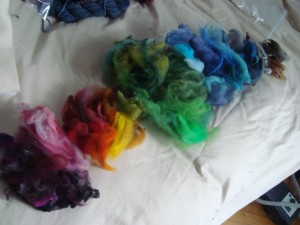
Moral of this story: Never assume that you are immune to any fiber craft, no matter how improbable it seems. (At least not if you’re me.)
Item the second:
The striped shawl sweater is now behaving beautifully. There were an awful lot of big bumps getting onto this road, but now that I’m on it I think it’s going to be much smoother. The points in the front are falling exactly where I expected them to:
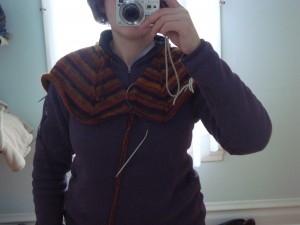
And the back is also laying nicely now.
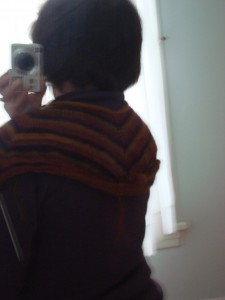
I’m not quite to the arm split yet, but if we get there without any more bumps in the road, then I think we’re home free.
Item the third:
I also finished spinning up the first “extra” skein of yarn for the main body of this project. I wasn’t sure how it would turn out, considering that I’d dyed the two batches of wool over 2 years apart.
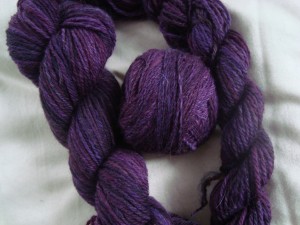
The ball in the middle is the old skein. The two on the sides are the new. I think that’s a pretty good match, don’t you?
I’m hesitant to attribute that to anything other than dumb luck, but I am pretty thrilled that I managed to get more of the same colorway after all this time.
Item the fourth:
Since I have now fully accepted that the striped shawl sweater is in fact going to be a sweater and not a shawl, that means that I have no good excuse not to just finish the shawl and be done with it. I sat down with my stitch dictionaries, and almost immediately stumbled across the perfect edging in Knitted Lace of Estonia. I spent days and days looking for border patterns last time I was working on this shawl, and this time it just fell into my hands. I’m taking that as a sign.
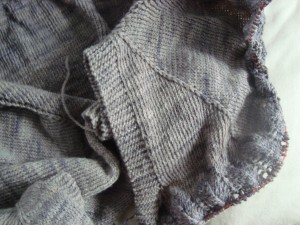
Unfortunately, each row takes about 45 minutes to knit, so it’s not exactly flying off the needles. Still, it’s making progress, and it should be ready to bind off soon. Yay for finished objects!
Item the fifth:
I was in need of a project that felt like it was going somewhere, so I whipped up a little instant gratification last weekend. I had just finished spinning up my sample of the Rambouillet top, with the aim of making a hat for Branden. It really doesn’t take long to knit a hat in worsted yarn, especially when it’s just a simple, simple hat with a little short row shaping.
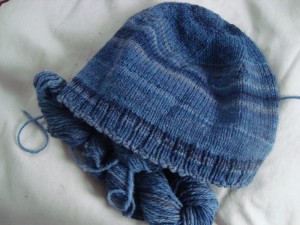
I was hoping for a modeled shot, but that’s why it hasn’t been blogged yet, and I bet you can imagine what a hat looks like on a head. I tried taking photos in the mirror, but it’s amazing how hard it is to take a picture of your own head.
I love how the colors came out on this one. They’re a tad bit greyer than they look in the photo, but I love those stripes. I ended up with about 220 yards of yarn, and the hat took almost precisely half. There should be enough left for a pair of handwarmers, too.
Item the sixth:
I have finished the first sleeve of the lace ribs sweater. I have no idea why this is taking me so long, besides the fact that I just don’t love knitting pieces flat. I usually do everything in the round, but the lace needs seams to keep its structure, and so it must be knit flat. Somehow, this is just never the project that I pick up first.
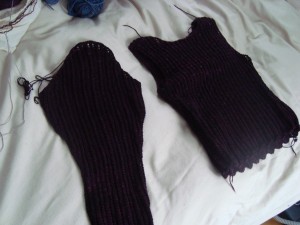
The good news is that the charts and instructions are almost done, so as long as the sleeve is actually the right size and shape after blocking, I should be almost done with the pattern.
The last item isn’t really an item, so much as it is something on my “must-catch-up” list. If I don’t get this fiber wrangled soon, it’s going to eat my office.
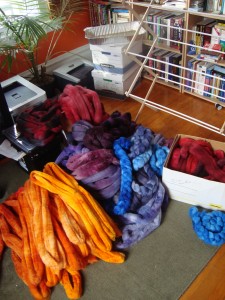
That is something like 48 braids worth of fiber. Those bankers boxes you see in the background? Also fiber, stuffed full to bursting. The stuff on the floor is waiting for photos and Etsy posting. Branden’s robotics team shipped their robot on Tuesday, so hopefully it will be a little easier to find time to take photos soon. (It’s kind of hard to find daylight picture time when he’s gone 4 days a week from morning until after I’m in bed, and at least half of the day on Saturday.)
Yellows and browns are next, but I’m holding off until after this batch is done. I don’t want to get swallowed up by the stash!
We’re almost all the way to a full rainbow now. I can’t wait to put them all together and see the full spectrum. And then, when the semisolids are done, I get to go back to the variegated colorways. So. many. ideas!
Sat 18 Feb 2012
Dyeing is the perfect winter sport. Just when I can’t stand the gray, I go into my basement and make this:
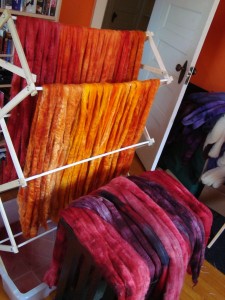
Yesterday’s colors were red and orange. Hopefully we’ll have real pictures soon, along with the purple and green. Let there be color!
Thu 2 Feb 2012
Between our recent photo-taking difficulties and just general laziness, I have gotten terribly behind in the posting of new fibers for the shop. There are two dye days ready to post, and another just waiting for photos (we’ll look at that one later).
I’m still working on beefing up my selection of semisolids, with an eye to producing colors that will go with more variegated colorways that I’ve been dreaming up and will hopefully get to dye soon. On the first dye day, I was trying to broaden my range of colors available in the Etsy shop. On the second day, I realized that I’m now dyeing for a show, and I need a wider selection of each color, and possibly even multiple copies of each one. The second dye day was all about blue, so you’ll see a lot of it here.
Since there’s a lot to cover, let’s go by breed, shall we?
I’ve had a few pounds of Shetland hanging around in my dyeing stock, waiting patiently for its turn to be dyed.
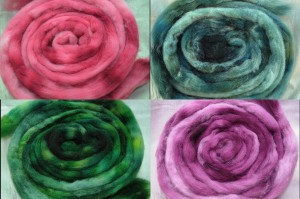
BFL is always a staple around here, so there’s quite a bit of that, too.

Along with a little Polwarth (because what’s a dye day without Polwarth?)
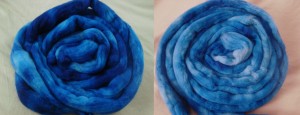
You can really see how much the camera has been acting up in those photos; the background fabric is the same for both, but it looks completely different. At least the fiber colors are finally right!
And finally, we have a couple of guest stars for the day. As I mentioned in my last post, I’m still working on sourcing more Targhee and Rambouillet fibers; the tradeoff of working with small farms is that they don’t have as steady an inventory as a bigger operation. The plus side is that they do have beautiful fibers:

That’s the Targhee, dyed up as semisolids. And then there’s the Rambouillet:

You can’t see it from the pictures, but the Rambouillet top is actually a lot thinner than the other fibers. When I braided it up, it was almost 3 times as long as the others! Since it’s such a crimpy fiber, the thinner preparation really cuts down on the amount of predrafting that’s necessary (and it makes you feel like you’re getting a lot more than 4 oz!)
And now for the pairings:
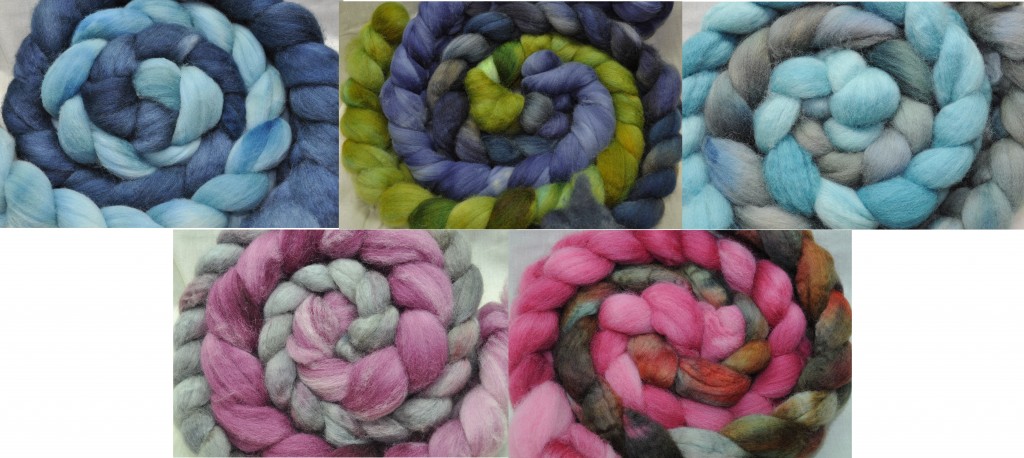
Top row:
Pale Teal Targhee and Slate Blue BFL
Spring Greens BFL, Denim Targhee, and Grey-Blue semisolid BFL
Pale Teal Targhee and Storm Greens Falkland
Bottom row:
Pale Purple Shetland and Silver Rose BFL
Cotton Candy Shetland and Cocoa Berry BFL
As always, all the colors are now available in the shop, and I have a whole batch of greens just waiting for pictures. More soon!
Tue 8 Nov 2011
The annual Fine Art of Fiber festival was this past weekend at the Chicago Botanic Gardens. The festival is put on by the Illinois Quilters, the North Suburban Needle Arts Guild, and the Weavers Guild of the North Shore.
We were expecting something fairly small, maybe a few rooms of pieces on display. We were completely unprepared for the size of this show. There were at least 3 display rooms with every surface covered in quilts, a display of handmade aprons, and two large rooms full of weaving and other crafts for sale.
I expected that we’d spend an hour or two and then go for a stroll around the gardens afterward. We spent the entire day.
This was one of my favorite pieces in the show. I love how the quilter used different values and saturations of color to really make the squares pop. It’s also interesting how the different colors interact; I wouldn’t usually think to mix pink and orange, but they complement one another beautifully here, and I think that contrast is part of what gives the quilt depth. Their placement also keeps your eye moving around the quilt, giving it a really dynamic feel.
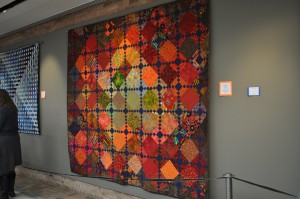
Quilting, like weaving, is all about color composition. It’s something I’m not very good at (yet), but I appreciate it in others’ work. We kept circling back around past this one throughout the day, and every time I passed I liked it more.
Here’s another one where the color pattern was carefully chosen to highlight the woven look of the quilt. This must have been an awful pain to construct, since those pieces  can’t be sewn as squares and have to be pieced as “L” shapes (corner seams don’t tend to like to lie flat).
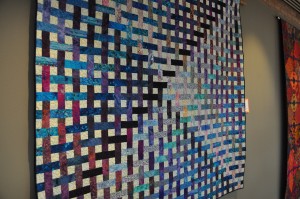
This one I liked for the sheer boldness of its design, and it’s jagged feel. It’s saw edges and z’s and broken glass all at once. Â I’ve read somewhere that there are certain commonalities in how sounds are represented across languages and cultures; that a curvy shape has a soft sound, and a sharp shape represents hard, crisp sounds. To me, this quilt is the visual equivalent of that. It practically crackles, doesn’t it?
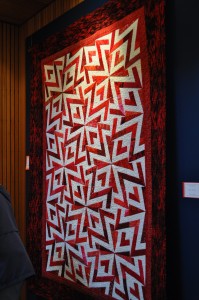
This was almost the exact opposite. Subtle, calm, understated. A forest of trees that is almost there, and almost not. I think the background fabric on this one was handpainted, too. Loved the color blending, and the way the three-dimensional leaves brought out the background.
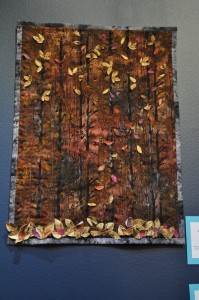
This piece was another jaw-dropper in terms of color composition.
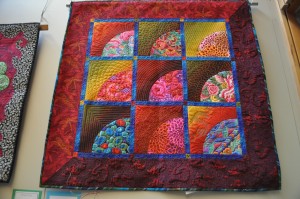
And just look at the details in the quilting!
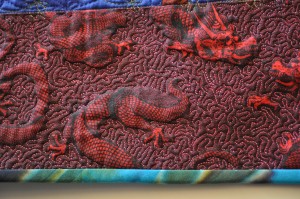
Another thing that this show really brought home is the importance of beautiful quilting to finish a piece. I don’t have much to show there, because it’s hard to take pictures that actually show quilting, but when well done, it really elevates a quilt from nice to spectacular.
Here’s an example of a very plain background that became a lot more interesting with quilting. All those flowers are quilted in. Without those details, the butterfly would be on a plain red background.
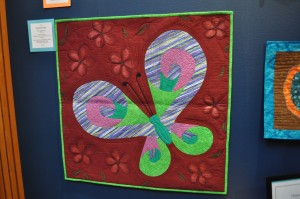
As with anything, I suppose, the genius is in the details, and in pulling them all together to make a coherent whole. It was fun to spend a day studying so many masterpieces.
There was a woman demonstrating bobbin lace, which I’ve been tempted to try for quite some time. She managed to make it sound quite simple despite its apparent complexity, too. Turns out that’s all just one “stitch” too. Just like knitting…you take one simple thing and make complicated patterns. She had a sample for people to practice on. I declined, out of fear of gaining another hobby on the spot. Fortunately, I know I will never run out of things to explore in the craft world.
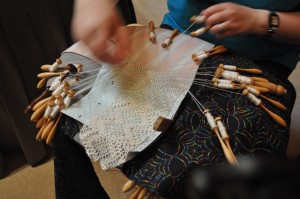
We also sat in on a lecture by the owner of Kasuri dyeworks about Japanese textiles. I didn’t take photos, but it was an amazing hour, packed full of information about the techniques of Japanese master dyers and weavers. There is so much history in those pieces of fabric. It literally takes a lifetime to master these crafts (she said that one of the weavers she works with is considered “up and coming” after 30+ years of apprenticeship). We found ourselves shaking our heads and saying “only the Japanese” so often during the lecture. There is so much careful attention to detail, so much miniaturized and painstaking work, and such emphasis on perfection of their craft. The fabrics were truly beautiful, and the culture behind them was just as interesting. I’d highly recommend that anyone sit in on one of these lectures if you get the chance; even if you don’t weave or dye, it was an amazing way to spend an hour.
We didn’t take photos of the woven pieces on display, unfortunately. They didn’t have any for show only, and people can be funny about you taking pictures of things that are for sale, so we opted to just look. I’ve decided that I really must play with huck lace, and have reinforced the idea that I want to weave very fine (50-100 ends per inch seems like a good goal for now, just as soon as I can get enough heddles to thread the loom with that many ends!). I also discovered that I like very lightweight chenille much, much more than the slightly heavier-weight kind that I’ve usually seen.
We saw some examples of garments with beautiful finishing details, which is of particular interest to me because that’s where my weaving is headed (eventually, anyway). Again, the details really make the piece. I only barely managed to avoid taking a finely finished jacket home with me as a new addition to my wardrobe. Next year, maybe.
In all, it was a long but fun day. So many inspiring things to see, a million more directions to explore. It did poke my dormant quilting itch, and has gotten my brain turning on some new ideas for weaving projects. Definitely an event to attend again next year. (And who knows…maybe to enter, too?)
Thu 27 Oct 2011
Ellen and I have been emailing about how we’ve both been in a bit of withdrawal since Rhinebeck. It’s a little harder than I expected to come back to real life after a fantastic weekend of friends and fiber. I’m thinking that perhaps it is time for a little reminiscence, yes?
(And a little revealing of purchases, too…can’t have a proper festival post without that.)
As usual, I had terrible camnesia for most of the trip, so this post will be link-heavy and picture light.
Fortunately, Ellen had the presence of mind to ask someone to take a picture of our group, while waiting in line for the fair grounds to open on Saturday:
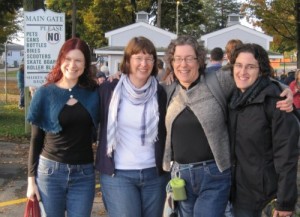
From left to right, that’s Karen, Cricket, Ellen and me (bet you couldn’t tell on that last one).
We all stayed together in a beautiful little cabin about 20 minutes from the fairground, which really was the perfect way to enjoy the festival. Ellen arranged that too. (You may be sensing a pattern here…)
Despite a heavy rainstorm on Friday night, we had a weekend of beautiful weather that was just right to highlight the fall foliage. Driving back and forth along all those winding country highways, it was all I could do not to pull over every 10 minutes to take a picture of the colors as the car rounded a bend into yet another beautiful landscape.
We all arrived late Friday night, had a great nights’ sleep after our travels, and then sprinted off for the fairgrounds first thing in the morning. First off, we investigated the fleece sale, where I was sorely tempted by an 8 pound Cormo. I managed to resist that one, but fell head over heels for this gray Corriedale cross from Lisa Lafferty at Eidelweiss Farm, which Ellen and I agreed to send off for processing and then split between us.
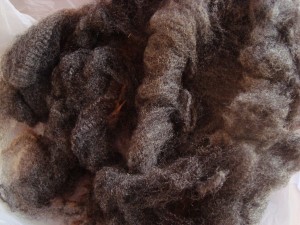
This is the first time I’ve sent a fleece off for processing. It does add a whole new dimension to buying raw fleeces (as well as cutting out many, many steps in between the buying and the spinning). Could be dangerous.
Then, we stood in line to meet the Yarn Harlot and get our books signed. Actually, we stood in three lines. One, to get to a copy of the book, then one to purchase the book, and a third to get it signed. Â Fortunately, there were other books and authors to look at and chat with along the way, and Ellen kept us entertained with her adorable little Jenkins Kuchulu spindle.
I picked up a copy of Sheepish along the way, which I’ve heard is a very good read.
Then, we began our wanderings around the fairgrounds. And there was much wandering to be done. I’ve just had a look at the fair map, and there were ten (ten!) barns chock full of fiber. You could go for days and not take it all in. Fortunately, we had Karen to read the map and make sure we knew where we were (and where we were going) at any given time. This is a big help when the rest of the crew is caught up in *shiny!*
Instead of doing my usual walk once around before buying, we just went straight for it and hit up the booths we thought were interesting. We found rare breed wools at Spirit Trails Fiber. I was bitten by the Targhee bug at Jefferson this year, Â and so ended up with 8 oz of that, even though I got in line expecting to buy 4 oz. Oops. I also bought 5 oz of Debouillet, since Rambouillet has been on my to-try list for a while now, and Debouillet sounded kind of close, and was very soft.
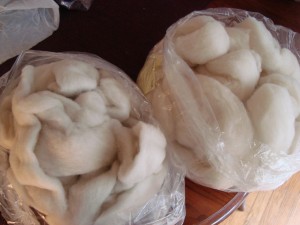
There was a whole booth full of incredible shetland sweaters from Yarns International. I didn’t buy any, but they’ve gone into my mental file of yarns I must try someday. Their colorwork was also stunning, but it was early in the festival and I hadn’t worked up the courage yet to start asking if I could take photos of sample pieces.
We stopped by the Fiber Optic booth to meet the dyer, Kimber, who I hear is very scientific. Unfortunately, she was also swamped, so I will have to find another time to stand around and talk shop. Her fiber is lovely, though. I ended up with a bag of Black Coffee pencil roving, and a gradient-dyed braid of Merino Tencel in Espresso Gold (must have needed a caffeine kick after the early start to our day).
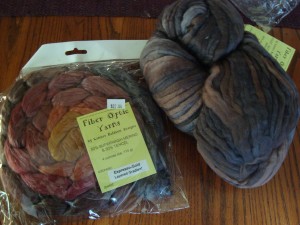
We also stopped by the Golding booth and had a look at their spindles. At one point, both Ellen and I turned around, saying “you’ve got to see this one” and then dissolved into laughter when we realized that we were holding two copies of the same spindle. Great minds think alike. (And you should see it spin!!!)
After lunch, we wandered the upper fairgrounds, passing by the Briar Rose and Sanguine Gryphon booths. Then, we watched a few sheep lose their coats:
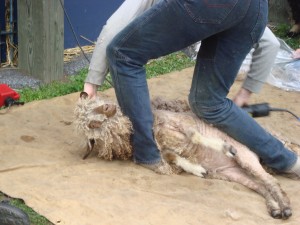
And took a tour of the show barns, including the breeds barn where Ellen picked out all the sheep she wants for her future farm (and for Jan’s…she’s such a thoughtful sister).
We also got to talk to Otto Strauch about his drum carders, which was very interesting. Both Ellen and I are in the researching phase of considering a drum carder purchase, so it was interesting to hear about all the technical details that make the Strauch carders unique.
At the end of the day, we realized that we had not sat down from the time we arrived at the fairgrounds until we got in the car to head off to dinner. You know it’s been a good day when you’ve forgotten to stop and sit.
We had dinner at a local brewery, where Cricket and Ellen dueled their way through the beer sampler, and Cricket kept us all in stitches. (Actually, she did that all weekend.)
We got back to the cabin late, but we had just enough time for a show-and-tell before bed, and a few more laughs. Ellen did some sample washing of fleeces in the kitchen sink, and we all oohed and aahed over the locks of freshly cleaned wool.
I headed back to the fairgrounds alone on Sunday morning, since I had a morning class and a few hours before my afternoon flight. The class was called Great Garments from Handwoven Cloth by Daryl Lancaster, and it was very, very good. I’ve done a good bit of garment sewing myself, but I learned so much about simple sewing techniques that just hadn’t come up in my self-taught career. Daryl is great at getting into the “why” of garment construction instead of just the rules. She also had tons of useful tips for stabilizing handwoven cloth, adding structure to garments, and finishing edges so that they stay put and don’t ravel. The class was only an hour and a half long, but it was jam-packed.
And then there were the samples. Here’s one of my favorites:
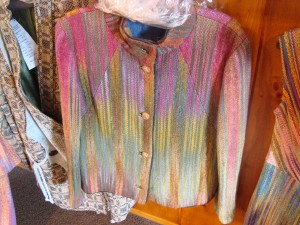
After class, I was in a weaving mood, so I visited the Just Our Yarn booth to peruse their samples. I just love looking at them all.
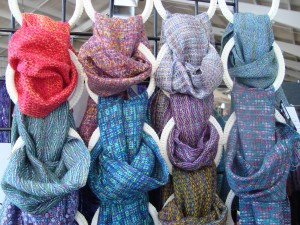
Look at the detail in this one:
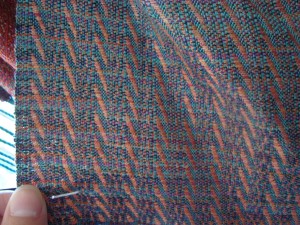
I just love how those colors work together, but wouldn’t have thought to put salmon and blue in the same piece. The owners are also wonderful to talk to about weaving; they know how each sample was made, and can talk at length about the structures and colors and yarn weights used to get a particular effect. I always learn so much from a visit to their booth. I have some of their yarn for a project already, and so forbore to buy more, but I did pick up a couple of books that are kind of the equivalent of weaving stitch dictionaries. There are years of exploration in these pages.
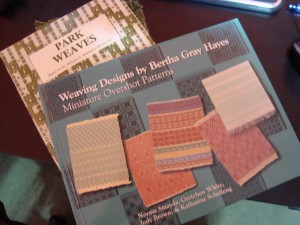
I also found a few things on the fairgrounds that we’d overlooked on Saturday. There were some very artistic carved pumpkins:
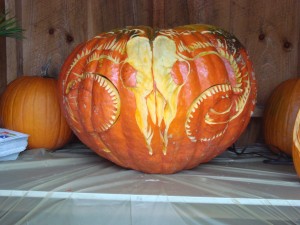
And a whole barn full of antique museum-displays. They had everything from the print shop to the formal parlor. I spent quite a while watching the clock maker repair the mechanism for a pendulum clock:
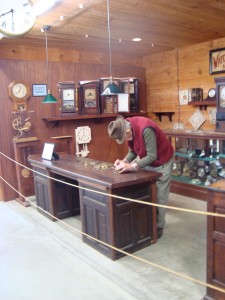
Here’s the print shop:
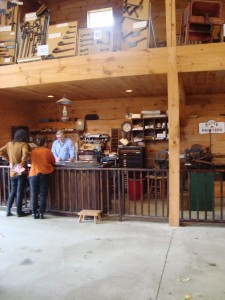
I got to use the mini moveable-type printing press, but didn’t take a picture of that one.
Then, I headed back into the yarn barns. I found this beautiful colorwork sweater by Decadent Fibers. It’s sold as a kit, but I really just wanted to sit and study those intricate colorwork designs. Might have to buy the pattern someday, just because.
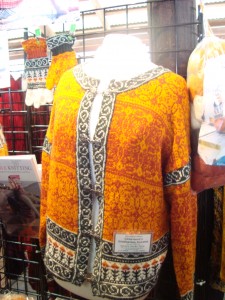
And these fantastic felted/leatherwork bags by Spiralworks. I just love the combination of felt and stylish leather bags.
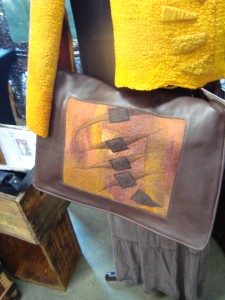
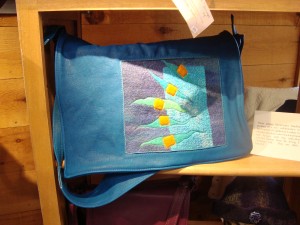
None of them made their way home with me, but it’s something to keep in mind when I need something special one of these days.
A couple of tiny braids of pure silk from Cloverleaf farms did manage to sneak into my bag:
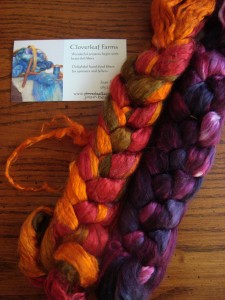
I bought the first one because I thought it might make the perfect trim to go with the fall colors sweater:
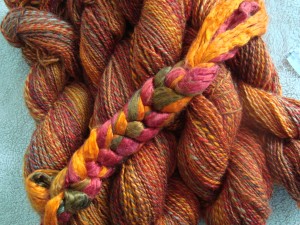
The red is looking a little pink next to the wool yarn, so I’m not sure if it will actually end up in the sweater. We may have to see what it looks like when spun up first. The second braid I bought just because. I’m not sure what they will become, but they are beautiful.
I also stopped off at the Briar Rose booth to show Chris my sweater and gush a bit about her yarn. I’ve just realized that I never actually showed a modeled photo on the blog, so here it is:
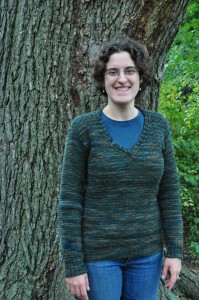
And here’s a closeup of the neck detail (that’s my favorite part).
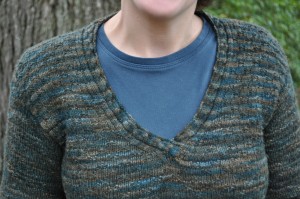
I had completely forgotten to take pictures; probably because I’ve been so busy figuring out how to wear it as often as possible. My sweater queue is completely full up right now, or I’d have bought yarn for another three right then and there. Honestly, I could buy every yarn in her booth.
And then, in my last few minutes of wandering, I ran into Anne, as I’ve already told you. I really had given up hope of finding her at that point, so it was just the perfect way to end the festival.
So that was Rhinebeck 2011. Two days packed full of fiber, fun, and friends. I’m not sure I could handle this much fiber activity on a regular basis, but I am looking forward to next year!
Tue 18 Oct 2011
When I gave Anne her fiber, she said lightly “oh, I’ll put it on the blog.” Then she said two words that puzzled me at first, and then sent me scurrying back to the dye studio in a hurry.
She said “be ready.”
It hadn’t really occurred to me that I might end up with a few extra visitors from all this, and that those visitors might like to find something in the shop to look at when they arrive. Gulp.
So, tonight I’m getting ready for visitors. (If you’re new, never, ever feel pressured to buy…I’ve written at length about my thoughts on that here.)
Fortunately, I always have a million color ideas floating around in my head that I just haven’t gotten to yet. I try to spread out the dyeing, so that it’s not all dyeing all the time around here. (I do like to spend some time talking about knitting, after all.) That inevitably means that there are color combinations that end up on the back burner, waiting until the time is right. I spent yesterday evening putting a few of those ideas onto fiber:
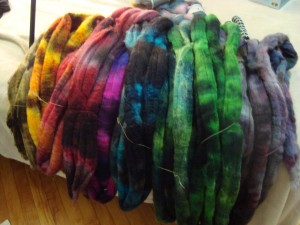
It’s a bit of a hodgepodge, as you might imagine. Of course, there are the fall colors, inspired by the beautiful foliage at Rhinebeck:
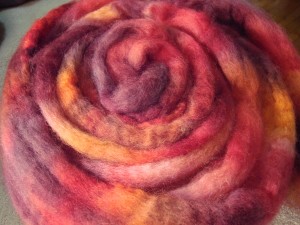
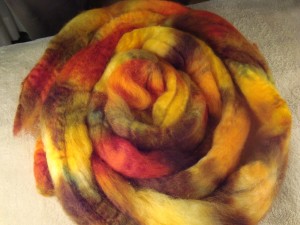
My favorite of these is yet to come; try as we might, we just couldn’t capture its color without natural light.
I also tried some brown, since I am always fascinated by the colors of fields lying fallow in the fall. There’s that deep, deep brown of the wet earth, mixed with the lighter brown of the fading grass. It’s the perfect backdrop for the fiery fall display.
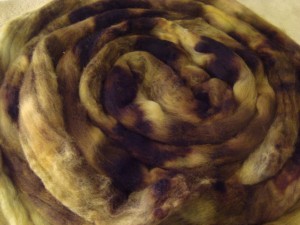
Then, there were a few bolder colorways. The first reminds me of the sky at sunset:
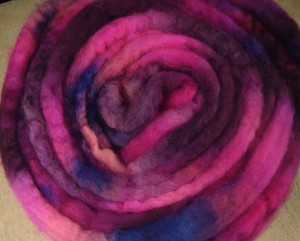
The second was a bit of a game. Somewhere in conversation over dinner on Saturday, someone suggested the Irish Pirate as a name for a colorway. Since I love to play with suggestions (leave some in the comments, or submit them on the color suggestion page), I decided to give it a try. I ended up with bright, bright Kelly green mixed in with black and golden treasure.
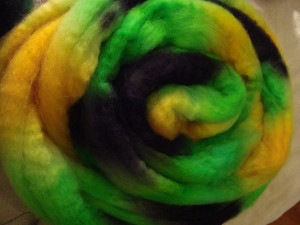
That got me into the mood for green, so I added in this mixture of saturated emerald and black:
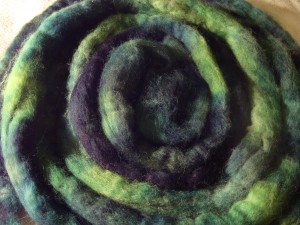
I also played around with olive, mixed with purple and gray, in a colorway based on the sage plant growing in my garden.
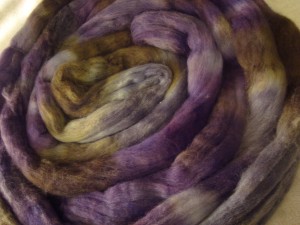
And then, because one can never have enough purple and gray, I dyed another with those two by themselves.
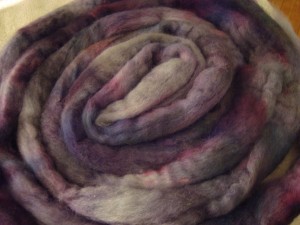
This is probably my favorite colorway of the day. Teal and black have been jumping out at me all over the place this fall, and I have been dying to put them together on fiber.
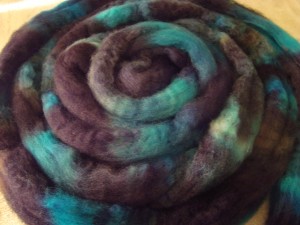
I just love the way this one came out. I used both turquoise and teal; the turquoise is lighter, and really pops out and lightens the colors. The teal is a deeper color and makes a more subtle contrast with the black.
There was just a little black dye left over, so I mixed it with deep reds and purples in a colorway I’ve been dreaming of for a long time now. There’s a particular picture of black cherries that I took a year or two ago, and I’ve been wanting to play with some of those shades. I can’t find the picture right off, but this fiber matches the image I have in my minds’ eye.
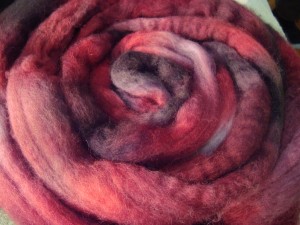
So that’s that. A big batch of random colorways, pulled from the back burners and neglected shelves of my mind. Things I’ve been wanting to dye, but hadn’t gotten to, for whatever reason. A wide sampling of the colors that we love, but only the smallest bit of all the possibilities out there. If you’re new here, welcome. There’s something for everyone, I hope. They’re all up on Etsy, should you see something that you absolutely must have.
With the next post, we should be back to our regularly scheduled content. I have fallen a bit behind the blogging wagon, so I have some catching up to do. More on that soon!

































































